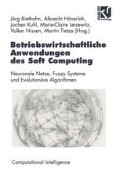Zusammenfassung
Wir geben hier eine Einführung in die populärsten Modelle und Lemver-fahren Künstlicher Neuronaler Netze. Nach einer Motivation und Charakterisierung der Neuronalen Netze werden ihre Komponenten und verschiedene Klassen von Lernverfahren vorgestellt. Anschließend werden das Prinzip und Probleme des Lernverfahrens Backpropagation und seiner Varianten erläutert. Cascade Correlation wird als Beispiel eines Lernverfahrens mit selbstbestimmter Netzwerktopologie gezeigt. AnschUeßend werden die Lernende Vektorquantisienmg und die Selbstorganisierenden Karten vorgestellt. Radiale Basisfunktionen-Netze werden als populäre Klasse von Netzen mit nicht-sigmoiden Aktivierungsfunktionen behandelt. Anschließend werden kurz noch einige neuere Entwicklungen von Lernverfahren angesprochen und ein Ausblick über die künftige Entwicklung gegeben.
Access this chapter
Tax calculation will be finalised at checkout
Purchases are for personal use only
Preview
Unable to display preview. Download preview PDF.
Literatur
Anderson, J.A.; Rosenfeld, E. (1988): Neurocomputing: Foundations of Research. MIT Press
Anderson, J.A. et al. (1990): Neurocomputing 2: Directions of Research. MIT Press
Boser, B. et al. (1992): A Training Algorithm for Optimal Margin Classifiers. 5th Ann. Workshop on Comput. Learning Theory, ACM Press, Pittsburgh: 144–152
Braun, H. (1997): Neuronale Netze — Optimierung durch Lernen und Evolution. Springer-Verlag
Brause, R. (1995): Neuronale Netze. Teubner
Chauvin, Y.; Rumelhart, D.E. (1995): Backpropagation: Theory, Architectures and Applications. Lawrence Erlbaum
Elman, J.L. (1990): Finding Structure in Time. Cognitive Science Vol. 14: 179–211
Fahlman, S.E.; Lebiere, Ch. (1990): The Cascade-Correlation Learning Architecture. In: Touretzky, D.S. (Hrsg.): Adv. in Neural Inf. Proc. Syst. 2. Morgan Kaufmann Publishers, Inc.: 524–532
Fahknan, S.E. (1989): An Empirical Study of Learning Speed in Back-Propagation Networks. In: Touretzky, D. et al. (Hrsg.): Proc. of the 1988 Connectionist Models Summer School. CMU, Morgan Kaufmann
Fahhnan, S.E. (1991): The Recurrent Cascade-Correlation Architecture. In: Lippmarm, R.P. et al. (Hrsg.): Adv. in Neural Inf. Proc. Syst. 3. Morgan Kaufmann: 190–198
Fritzke, B. (1992): Growing Cell Structures — A Self-Organizing Network in k Dimensions. In: Aleksander, L; Taylor, J. (Hrsg.): Artificial Neural Networks II. North Holland: 1051–1056
Fritzke, B. (1993): Vector Quantization with a Growing and Splitting Elastic Net. ICANN 93, Int. Conf. on Artificial Neural Networks. Amsterdam: 580–585
Glesner, M., Pöchmüller, W. (1994): Neurocomputers — An Overview of Neural Networks in VLSI. Chapman & Hall
Göppert, J. (1997): Die topologisch interpolierende selbstorganisierende Karte in der Funktionsapproximation. Shaker-Verlag
Hebb, D.O. (1949): The Organization of Behavior. Wiley, New York; Auszüge auch in [Anderson/Rosenfeld 1988]: 45–56
Hertz, J. et al. (1991): Introduction to the Theory of Neural Networks. Addison-Wesley
Hopfield, JJ. (1988): Neural Networks and Physical Systems with Emergent Collective Computational Abilities. Proc. of the National Academy of Sciences USA Vol. 79: 2554–2558; auch in [Anderson/Rosenfeld 1988]: 460–464
Hopfield, J.J.; Tank, D.W. (1985). Neural Computation of Decisions in Optimization Problems. Biological Cybernetics 52:141–152
Jacobs, R.A. et al. (1991): Adaptive Mixtures of Local Experts. Neural Computation Vol. 3(1): 79–87
Jordan, M.I.; Jacobs, R.A. (1992): Hierarchies of Adaptive Experts. In: Moody, J. et al. (Hrsg.): Adv. in Neural Inf. Proc. Syst. 4 (NIPS-4), Morgan Kaufmann
Jordan, M.L; Jacobs, R.A. (1994): Hierarchical Mixtures of Experts and the EM Algorithm. MIT AI-Memo AIM-1440, Sept. 1993: 29ff; auch in: Neural Computation Vol. 6(2)
Kohonen, T. (1982): Self-Organized Formation of Topologically Correct Feature Maps. Biological Cybernetics 43: 59–69; auch in [Anderson/Rosenfeld 1988]: 511–522
Kohonen, T. (1989): Self-Organization and Associative Memory. 3. Aufl., Springer Series in Information Sciences, Springer-Verlag
Kohonen, T. (1990): The Self-Organizing Map. Proc. of the IEEE Vol. 78 (9): 1464–1480.
Kohonen, T. (1995): Self-Organizing Maps. Springer-Verlag
McClelland, J.L.; Rumelhart, D.E. (1987): Parallel Distributed Processing: Explorations in the Microstructure of Cognition, Vol. 2: Psychological and Biological Models. MIT Press
Moller, M. (1993): A scaled conjugate gradient algorithm for fast supervised learning. Neural Networks Vol. 6 (4): 525–533
Osuna, E. et al. (1997): An Improved Training Algorithm for Support Vector Machines. MIT
Poggio, T.; Girosi, F. (1989): A Theory of Networks for Approximation and Learning. MIT, A.I. Memo No. 1140
Riedmiller, M.; Braun, H. (1992): Rprop — A Fast Adaptive Learning Algorithm. University of Karlsruhe, Technical report
Riedmiller, M; Braun, H. (1993): A Direct Adaptive Method for Faster Backpropagation Learning: The RPROP Algorithm. ICNN-93, IEEE Int. Conf. on Neural Networks, San Francisco, CA: 586–591
Ritter, H. et al. (1990): Neuronale Netze: Eine Einführung in die Neuroin- formatik selbstorganisierender Netzwerke. Addison-Wesley
Rojas, R. (1993): Theorie der neuronalen Netze. Springer
Rumelhart, D.E.; McClelland, J.L. (1986). Parallel Distributed Processing: Explorations in the Microstructure of Cognition, Volume 1: Foundations. The MIT Press
Shepherd, A.J. (1997): Second Order Methods for Neural Networks — Fast and Reliable Traiiüng Methods for Multi-Layer Perceptrons. Springer
Specht, D.F. (1990). Probabilistic neural networks. Neural Networks 3: 109–118
Vapnik, V. (1995): The Nature of Statistical Learning Theory. Springer- Verlag, New York
Werbos, P.J. (1974): Beyond Regression: New Tools for Prediction and Analysis in the Behavioral Sciences. Ph.D thesis. Harvard University, Cambridge, MA; auch in [Werbos 1994]
Werbos, P.J. (1994): The Roots of Backpropagation: From Ordered Derivatives to Neural Networks and Political Forecasting. Wiley
Widrow, B.; Hoff, M.E. (1960): Adaptive Switching Circuits. 1960 IRE WESCON Convention Record, New York, IRE: 96–104; auch in [Anderson/Rosenfeld 1988]: 126–134.
Zell, A. (1994): Simulation Neuronaler Netze. Addison-Wesley, Nachdruck im Oldenbourg-Verlag, 1997
Author information
Authors and Affiliations
Editor information
Rights and permissions
Copyright information
© 1998 Friedr. Vieweg & Sohn Verlagsgesellschaft mbH, Braunschweig/Wiesbaden
About this chapter
Cite this chapter
Zell, A. (1998). Einführung in Künstliche Neuronale Netze. In: Biethahn, J., Hönerloh, A., Kuhl, J., Leisewitz, MC., Nissen, V., Tietze, M. (eds) Betriebswirtschaftliche Anwendungen des Soft Computing. Computational Intelligence. Vieweg+Teubner Verlag. https://doi.org/10.1007/978-3-322-86843-5_1
Download citation
DOI: https://doi.org/10.1007/978-3-322-86843-5_1
Publisher Name: Vieweg+Teubner Verlag
Print ISBN: 978-3-528-05596-7
Online ISBN: 978-3-322-86843-5
eBook Packages: Springer Book Archive

